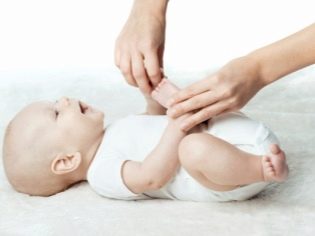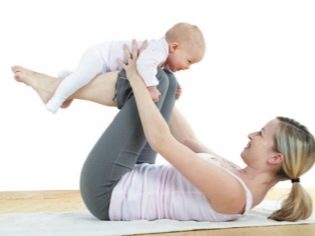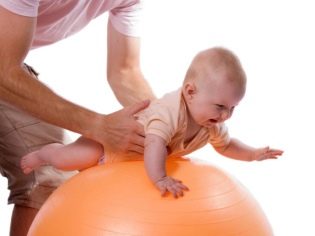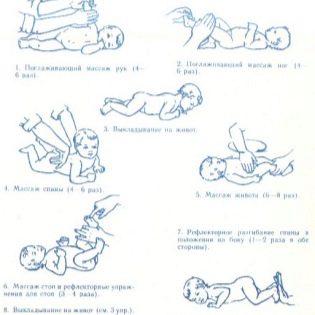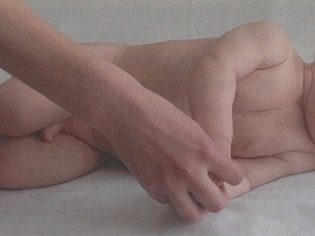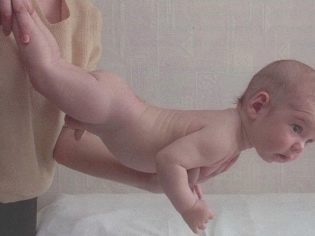Gymnastics for newborns from the first days of life
A newborn baby spends most of its time in a dream. So nature itself helps him to go through a period of adaptation to a new world. In the dream, all processes are softer. The newborn is awake quite a bit - no more than two hours a day. His awakenings are most often associated with natural needs - the desire to eat, wet diapers or abdominal pain due to colic. Short periods of wakefulness can and should be used skillfully.
For the development of the baby will be useful special gymnastics, which is allowed literally from the very first days of life. About how and why to do it, we will tell in this article.
Benefit
The benefits of gymnastics for newborns few people have questions: charging is never detrimental, if done correctly. For babies who have just been born, gymnastic exercises are of particular importance.
After nine months in the maternal womb, carried out in quite cramped conditions (it was especially closely in the last 2 months before the birth), there is nothing surprising in the physiological hypertonia of the muscles, which is registered in almost all infants. Gymnastics helps to quickly get rid of excessive tension in the muscles, the baby gets the opportunity to grow and develop physically in more comfortable conditions.
Gymnastics is not just a set of exercises. In any case, the baby sees her differently: for him this is the possibility of close tactile contact with his mother. His absence or lack of lead to poor emotional development of the child, to slow down his mental development.
Gymnastics improves blood circulation, which has a good effect on appetite, digestion and sleep quality: children sleep more deeply and peacefully. Develop muscles, strengthen joints and ligaments. All this will then come in handy for the child when he begins to master coups, crawling, walking. Dr. Komarovsky, whose opinion has weight for many moms, believes that gymnastics and hardening from the very first days is the key to a healthy and strong immunity in the future.
Contraindications
Relative contraindications to gymnastic exercises for newborns are congenital heart defects, hemangioma, as well as the presence of a large umbilical or inguinal hernia. Sometimes doctors recommend refraining from gymnastic exercises for certain congenital diseases of the joints and the musculoskeletal system, for example, if the hip joints are immaturity, you need to do special, therapeutic exercises and only when the baby is a little older.
Gymnastics do not do if a child has vomiting, diarrhea, fever.
Be sure to ask a question about the possibility of practicing a pediatrician - he will visit you the next day after discharge from the hospital. The overwhelming majority of babies allow doctors to do such classes, and with pleasure: the mother’s desire to develop her child is always commendable.
General principles
If there are no contraindications, it is advisable to begin to engage with a child from 1.5-2 weeks. By this time, the baby is quite well adapted to the new habitat. Mom, who intends to do gymnastics with a child, needs to know some general rules that will help to achieve maximum benefit and make the process of classes interesting and enjoyable for everyone.
- Engage with your child every day.Only daily gymnastics, and not a couple of exercises from time to time will be useful and effective.
- For classes, use a flat surface that will not fall under the weight of the baby - a table, tabletop, changing table or dresser cover.
- Repeat each exercise no more than 3-5 times, this is quite enough so that the baby does not get tired.
- Turn a lesson into a game - with verse, song and jokes. Baby is sure to enjoy it.
- Do gymnastics in a ventilated room, in which it is not hot (no more than 21 degrees of heat), remove diapers and all clothes during gymnastics. In summer, if it is warm and not rainy outside, you can do gymnastics in the open air.
- Forcing a child to do exercises is impossible. If the baby is naughty and crying, do not continue to do the exercises. It will be possible to return to gymnastics when the child is set up to play and socialize.
- When composing a gymnastics program for your child, choose only those exercises that are suitable for him by age, because excessive exercise can harm.
- Do exercises that will promote the symmetric development of paired muscles to prevent the predominance of one-sided muscle activity.
- Set the class duration to 10 minutes. To begin with - no more than 2 minutes, then every two days, increase the time by one minute until you reach the ten-minute “workout”.
Charging can be carried out several times a day:
- after awakening and morning hygiene procedures - morning;
- gymnastics in combination with a general tonic massage - in the morning;
- several relaxing exercises as part of a soothing evening massage, which is done before bathing.
Exercise gymnastics on heated muscles, even if you do not perform a pre-massage: rub hands, arms, legs, abdomen and back, easily, before moving on to a set of exercises.
Also, make sure that the child is not hungry at the time of class, because hunger will distract him, the baby will begin to cry. It is dangerous to do the exercises immediately after a meal - this can provoke plentiful regurgitation.
It is best to schedule a session an hour and a half after meals or an hour before the next feeding.
Classic charging for babies from 0 to 3 months
Classic exercises can be combined with massage, air baths. Good techniques of classical gymnastics are suitable for a morning lesson, which mother spends after washing and treating the navel. Classical gymnastics is performed in a static position: the child is in a stable position in space. This is the main difference between a classic complex and a dynamic one, which we describe below.
Mom on the note can advise a few game exercises, which are sure to be useful to the mother of the infant baby from 2 weeks to 2 months.
- "Caterpillar". Starting position - lying on his stomach. Mom brings the palm to the feet of the baby and gently pushes them forward forward. The kid reflexively creeps forward. This is how the abdominal, leg and back muscles are trained. Crawling is practiced from an early age precisely for this, and not at all in order to teach a child to crawl, as many people think.
- "Embryo". The position that the child needs to take in the course of this exercise is quite simple and familiar to him. In her child was in my mother's womb. Lay the baby on its side, move your knees to your stomach, and hold the handles against your chest. Lightly tilt the baby's head with his chin down to the chest. Hold him in this position for 15-20 seconds, then release. Repeat 4-5 times.
- "Topotun." Raise the baby, grabbing under the arms, let your toes rest against the surface of the table and move the baby forward. He will reflexively make "steps" on the table.Do not relax your hands, the weight of the child in any case should not fall on his immature limbs and spine.
- "Bicycle". Starting position - lying on your back. Take the legs of the baby in your hands above the ankle and make movements characteristic of cycling.
- "Worm". Starting position - lying on its side. Slide your fingers along the spine of the child without pressure and pressure. Reflexively the kid will kick the back, and then return it to its original position.
- "Athlete". Starting position - lying on your back. Take the hands of the baby in your hands. Bring them to the chest, dissolve in different directions, then lift up and lower along the body. The first time increased muscle tone will significantly limit the rise and lowering, make sure that the child does not hurt.
If a child is more than two months old and his age is approaching 3 months, it is quite possible to complicate the program of classical gymnastics with the following exercises:
- "Dolphin." Starting position - lying on his stomach. Put your palms under the chest and belly of the child, for a few seconds, raise it low on the palms above the surface of the massage table. All muscle groups, especially neck, back muscles and abdomen tighten. The back will bend, and the head will rise higher. Then gently lower the baby back to its original position. Repeat 3-4 times.
- "Skier". Put the baby on the back, take one leg by the foot, gently straighten it in the knee and slide the foot with the foot in the palm of your hand. Then do the exercises for the second leg in the same way. It will be like running a skier.
- The following exercise is quite difficult, it is recommended to start doing it not earlier than 3 months of age. It is called "Spindle". Its essence is in the training of oblique abdominal muscles and long back muscles. Lay the baby on the back. Grab the legs with one hand, pull the right handle with the other hand, while pulling the legs to the left. Baby roll over on his stomach. Then practice coups across the opposite side.
You can add fitball exercises - both on the back and on the stomach.
Dynamic charging
This type of gymnastics for infants belongs to the category of developing. Exercises are used more complex, they are all held in motion with a change in body position of the child in space. Swing, rotation helps not only to develop the muscular system, but also effectively train the vestibular apparatus of the child.
Dynamic exercises have more contraindications than classical ones, and therefore, in addition to consulting a doctor, it is desirable for parents to get a couple of lessons from an exercise therapy specialist. This type of gymnastics is not shown when crooked, weakness and underdevelopment of the joints. For a start, a mother can visit the gymnastics room in the clinic, take a few group classes with the baby, only after that it is possible to apply the acquired skills at home - naturally, with caution and adherence to the exercise technique.
Dynamic gymnastics programs can be different, here are just a few exercises for home use.
- "Pilot". Put the baby on your stomach. With one hand tightly clasp the wrist of the crumbs, and the second - the leg in the lower leg from the same side. Raise the baby for a few seconds and gently lower it back. Repeat the exercise with the handle and the leg on the other side.
- "Climber". Starting position - lying on your back. Grab the baby's legs with your hands just above the ankles, slightly lift the child by the legs so that the legs are in the air and the head is on the table. Shake it slightly and gently lower it back.
- "Airplane". This exercise everyone knows. His performance is better to entrust the Pope, his hands are stronger than his mother's. With one hand, take the baby lying on the belly under the chest, the second - under the tummy from the opposite side. The baby should be well fixed.Roll it around the room, depicting the sound of an airplane, change the height of the “flight”, you can circle the baby several times. It is not necessary to throw the child into the air and catch him, as some of the older generation do, this creates an excessive load on the spine and pelvic bones.
Dynamic gymnastics, according to supporters of its use, allows not only to develop the baby, but also to strengthen the psychological trust between the child and the adult. Many experts recommend starting her newborn from 1 month.
Such gymnastics has its ill-wishers, who are confident that there is no point in exposing the child to traumatic danger. To practice or not is up to you. Specialists in physical therapy and educational video tutorials will help you in training. There are a great many on the Internet.
Useful tips and reviews
Gymnastics by itself will not bring a tangible benefit to the child if the parents do not create normal conditions for classes: you need to humidify the air in the room (recommended humidity parameters of 50-70%), monitor the air temperature. During the lesson there should be no drafts.
Great results are achieved by parents who combine gymnastics with cool baths according to Dr. Komarovsky’s method, air baths, other restorative techniques, as well as art therapy methods (music therapy, fairy tale therapy).
Parents who from the first days began to do gymnastics for the child, by the first birthday of the baby usually boldly assert that their children are ill less often, develop better, learn age skills faster. Many of them a year, according to reviews, walk quite confidently.
Gymnastics, according to moms (and pediatricians fully agree with them), expands not only the limit of physical abilities, but also increases mental and intellectual development, contributes to the earlier development of the speech of the toddler, increases his ability to learn and memorize.
In the next video, physical rehabilitation therapist Olga Yashnaya will teach young parents special physical training exercises for the youngest and tell why they are so important to your baby.






